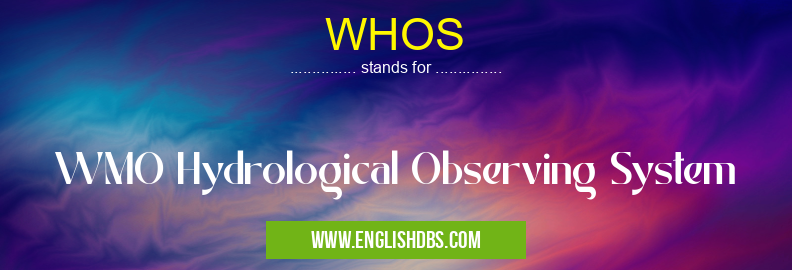What does WHOS mean in UNCLASSIFIED
WHOS is a global system of hydrological observing stations that collect data on the Earth's water resources. It is operated by the World Meteorological Organization (WMO) and its member countries. WHOS data is used to monitor water resources, forecast floods and droughts, and assess the impacts of climate change.

WHOS meaning in Unclassified in Miscellaneous
WHOS mostly used in an acronym Unclassified in Category Miscellaneous that means WMO Hydrological Observing System
Shorthand: WHOS,
Full Form: WMO Hydrological Observing System
For more information of "WMO Hydrological Observing System", see the section below.
- WHOS stands for WMO Hydrological Observing System. It is a global network of hydrological stations designed to collect and share data on the world's water resources.
Purpose
- The primary goal of WHOS is to provide accurate and timely information on the status of water resources, including:
- River discharge
- Water levels
- Water quality
- Sediment transport
Importance
- WHOS data is essential for:
- Water resources management
- Flood forecasting
- Drought monitoring
- Climate change research
Network
- WHOS is made up of over 10,000 hydrological stations located in all parts of the world.
- These stations are operated by national hydrological services and other organizations.
Data Collection
- WHOS data is collected using a variety of methods, including:
- Manual observations
- Automated sensors
- Remote sensing techniques
Data Sharing
- WHOS data is shared through a variety of platforms, including:
- The Global Runoff Database
- The World Meteorological Organization's Information System
- This data is available to researchers, policymakers, and the general public.
Essential Questions and Answers on WMO Hydrological Observing System in "MISCELLANEOUS»UNFILED"
What is the WMO Hydrological Observing System (WHOS)?
What types of data does WHOS collect?
WHOS collects a wide range of data on water resources, including:
- River discharge
- Lake and reservoir levels
- Groundwater levels
- Water quality
- Sediment transport
- Ice and snow cover
- Meteorological data
How is WHOS data used?
WHOS data is used for a variety of purposes, including:
- Monitoring water resources
- Forecasting floods and droughts
- Assessing the impacts of climate change
- Water resources planning and management
- Scientific research
Who has access to WHOS data?
WHOS data is freely available to all users. It can be accessed through the WMO's Global Hydrological Observing System (G-HOS) website.
How can I contribute to WHOS?
You can contribute to WHOS by sharing your water-related data with the WMO. You can also volunteer to help with data collection and analysis. For more information, please visit the WMO's website.
Final Words:
- WHOS is a valuable tool for water resources management. It provides accurate and timely data on the status of the world's water resources, which is essential for making informed decisions about water use and management.
